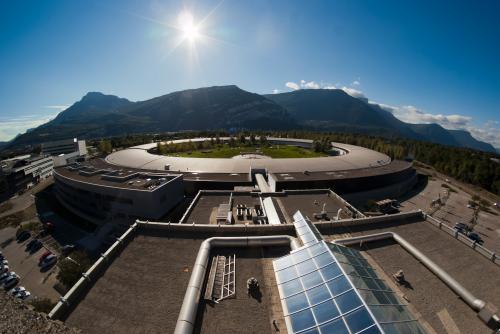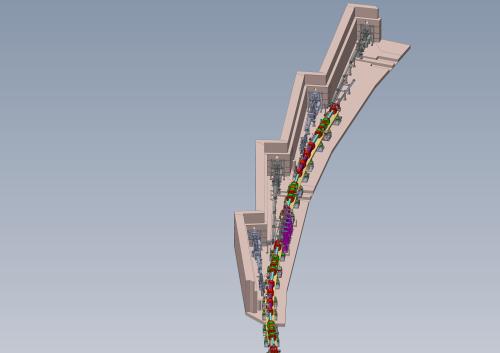- Home
- News
- General News
- The ESRF launches...
The ESRF launches the second phase of its Upgrade Programme
03-07-2014
The ESRF Council has expressed unanimous support for the implementation of the second phase of the ESRF Upgrade Programme and approved the related Technical Design Report. Over the next six years, the ESRF plans to bring into operation a new synchrotron X-ray source, housed in the existing buildings, and replacing the present machine operational since 1992. The objective is to deliver, by 2022, a fully renewed facility for the benefit of scientific users from around the world, and to enable the ESRF to remain the global leader in synchrotron X-ray science.
"Today, the ESRF is the key to the success of a user community of more than 10,000 scientists, from Europe and further afield, whose discoveries expand our knowledge”, said Francesco Sette, ESRF Director General. “A significant part of their studies is at the crossroads of research, innovation and industry. With the new X-ray source and beamlines, we will make it possible to continue this endeavour for another twenty years to come, allowing scientists to carry on working towards answering some of society’s crucial questions, such as on how to make and store renewable energy, discovering new drugs and medical treatments, and inventing new smart and sustainable materials", he added.
The improvement of the synchrotron’s source properties and scientific instrumentation, planned in the ESRF Upgrade Programme, will enable completely new X-ray microscopy and imaging and nano-crystallography applications, with a performance enhancement that goes all the way up to a million times (106) that of the present third generation sources, yet the new design will use 20 percent less wall-plug energy.
The scientific community at large is very interested in the new horizons opening up in X-ray science, where X-ray microscopy techniques will enable bridging the present gap between optical and electron microscopies. With these new technological advances, the community sees ‘almost infinite’ applications in condensed matter science, innovative materials research and life sciences.
The current plans aim to maintain user operation with the existing X-ray source uninterrupted until October 2018 and to open the new storage ring source to users in June 2020, after some 20 months of shutdown. By 2022, four new state-of-the-art beamlines will be delivered along with breakthrough improvements in detectors and big-data infrastructures across the whole ESRF, allowing scientists to take full advantage of the new X-ray source.
Along with its support, the ESRF Council expressed its desire to maintain and strengthen Europe's worldwide leadership in synchrotron science and instrumentation and to pioneer new technological advances that can be utilised in future upgrades by other synchrotron centres across Europe.
View of the current ESRF synchrotron from above
The ESRF, at its inauguration in 1994, was the world's first third generation synchrotron X-ray source achieving record-breaking performances that paved the way for the construction of more than 20 other synchrotrons worldwide. During this 20-year period, and as a result of the first phase of the Upgrade Programme that started in 2009, the performance – brightness – of the ESRF X-ray source was further increased to values beyond even the most optimistic expectations at the time of its design. Taken together with the continuous improvements of the beamlines, the ESRF today offers its users unique capabilities in all fields of X-ray science and applications. Recent breakthroughs have come, among other areas, in micro crystallography, in time-resolved spectroscopy of materials under extreme conditions and in the electronic properties of nano-structured materials.
However, the third generation technology of synchrotron X-ray sources is now more than twenty years old, and the last decade has seen global efforts to design and eventually build yet further advanced electron storage rings for X-ray science. These machines would produce even more brilliant X-rays by reducing the horizontal size of the electron beams circulating the machine by a factor of 30 to 40.
It was generally believed that building these so-called diffraction-limited storage rings would require an entirely new synchrotron to be designed and constructed in addition to the development of numerous new critical technologies – as was the case for the ESRF 25 years ago.
In 2012, the ESRF announced an innovative design concept that would allow a substantial decrease of the electron beam horizontal size which, at the same time, could be realised in the existing ESRF storage ring tunnel using proven technologies.
A model of the new lattice design. CREDIT: ESRF's Accelerator Project team.
The ESRF accelerator team has been a key player in these global discussions about future "ultimate X-ray sources" as well as in understanding the technological implications of their practical realisation. This concept, which caused worldwide excitement, has now matured into a full technical design for the ESRF, which permits more than 90% of the existing ESRF infrastructure to be re-used, including its entire beamline portfolio.
The challenge to produce an electron beam with much smaller horizontal emittance – compatible with existing infrastructure and injector accelerator complex – has been solved by the innovative ESRF storage ring lattice design using a breakthrough magnetic structure: seven bending and 33 focusing magnets in each of the machine's 32 sectors; more than 1000 magnets in total will be packaged into the limited space of the existing building.
This new design, benchmarked in many accelerator centres worldwide, is already being adopted by other synchrotron facilities. Its other advantage is that it substantially reduces the energy loss per turn, resulting in lower operation costs due to decreased electricity consumption.
More details about the ESRF upgrade can be found in the latest edition of the ESRF newsletter: ESRF News
Top image: The latest edition of ESRF News focuses on the ESRF upgrade - a link to the publication is available at the bottom of this article.





